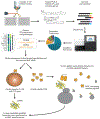Rebooting Human Immunology
- PMID: 29490162
- PMCID: PMC6677260
- DOI: 10.1146/annurev-immunol-042617-053206
Rebooting Human Immunology
Abstract
Recent progress in both conceptual and technological approaches to human immunology have rejuvenated a field that has long been in the shadow of the inbred mouse model. This is a healthy development both for the clinical relevance of immunology and for the fact that it is a way to gain access to the wealth of phenomenology in the many human diseases that involve the immune system. This is where we are likely to discover new immunological mechanisms and principals, especially those involving genetic heterogeneity or environmental influences that are difficult to model effectively in inbred mice. We also suggest that there are likely to be novel immunological mechanisms in long-lived, less fecund mammals such as human beings since they must remain healthy far longer than short-lived rodents in order for the species to survive.
Keywords: CMV; human evolution; human immunology; systems immunology.
Figures




References
-
- Steinman RM, Mellman I. 2004. Immunotherapy: bewitched, bothered, and bewildered no more. Science 305(5681):197–200 - PubMed
-
- Quintana-Murci L, Alcaïs A, Abel L, Casanova J-L. 2007. Immunology in natura: clinical, epidemiological and evolutionary genetics of infectious diseases. Nat. Immunol 8(11):1165–71 - PubMed
Publication types
MeSH terms
Substances
Grants and funding
LinkOut - more resources
Full Text Sources
Other Literature Sources
Medical

